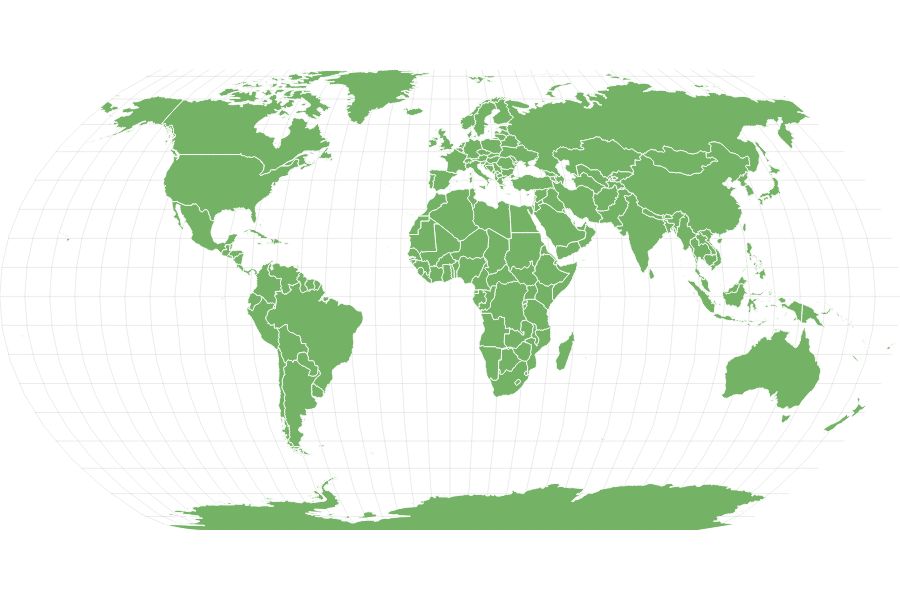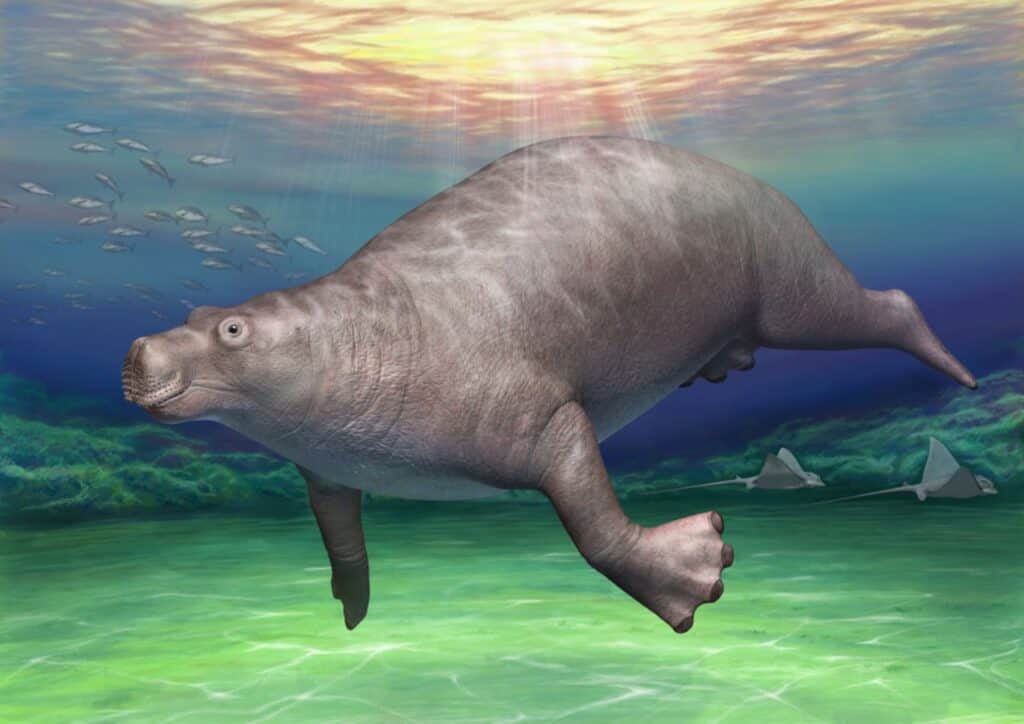Scientists were able to determine that Paleoparadoxia was exclusively aquatic by comparing the rib cages of fossils to modern species of mammals like dugongs and polar bears.
Advertisement
Paleoparadoxia Scientific Classification
- Kingdom
- Animalia
- Phylum
- Chordata
- Class
- Mammalia
- Order
- Desmostylia
- Family
- Paleoparadoxiidae
- Genus
- Paleoparadoxia
Read our Complete Guide to Classification of Animals.
Paleoparadoxia Conservation Status

Paleoparadoxia Facts
- Fun Fact
- Scientists were able to determine that Paleoparadoxia was exclusively aquatic by comparing the rib cages of fossils to modern species of mammals like dugongs and polar bears.
- Biggest Threat
- Food competition
- Habitat
- Bottom of oceans
View all of the Paleoparadoxia images!
Millions of years ago, a mysterious genus of animal called Paleoparadoxia once swam and foraged in the Pacific Ocean. These herbivorous animals inhabited a wide range stretching from the shores of Japan all the way to the cool waters along the Pacific Coast of North America.
Description & Size
The Paleoparadoxia is a genus of large aquatic mammals. This species likely lived on sea grasses and similar flora. They inhabited the northern Pacific coastal region around the Miocene epoch.
- The Paleoparadoxia’s name means “ancient paradox” or “ancient puzzle.”
- Originally, this species was thought to be amphibious. Paleoparadoxia is now thought to have been a marine mammal, similar to a whale or dolphin. However, they likely walked along the bottom of the ocean.
- Size estimates vary, as different fossils are vastly different sizes.
- These giant creatures are estimated to weigh between 1,048 kilograms (2,310 lbs) and up to 3200 (7,054 lbs) of body mass.
- Unlike most sea creatures, they have legs to walk on the seafloor.
Diet – What Did Paleoparadoxia Eat?
The Paleoparadoxia is thought to have fed on seaweeds and similar plants. The jaw and teeth of this marine mammal look like a backhoe bucket. Paleoparadoxia was completely herbivorous and generally ate any plant life found in the ocean.

Millions of years ago, the Paleoparadoxia could be found foraging on sea grasses across the depths of the Pacific Ocean.
© – License
The jaws and the angle of the teeth, along with its large body, made it extremely capable of swimming and foraging underwater.
Paleoparadoxia did not chew or eat like any other known animal. It clenched its teeth and rooted up plants with the help of its powerful neck. Then, it sucked the plants in using strong throat muscles and the shape of the roof of its mouth.
Habitat – When and Where It Lived
This species lived from the Aquitanian through to the Tortonian of the Miocene. Fossils of Paleoparadoxia are found in many places in Japan, including the Haratajino Formation, Kurosedani Formation, Nagura Formation, Niwaya Formation, and Saitama Prefecture.
Fossils are also found in the United States, mostly around California, in places such as the Ladera Sandstone Formation, Monterey Formation, Oclese Sand Formation, Santa Margarita Formation, and Schooner Gulch Formation. Paleoparadoxia fossils are also found in Mexico in the Torgugas Formation.
They are believed to be aquatic because of a combination of characteristics. Their legs seemed adapted for terrestrial locomotion, while several other parameters confirm their aquatic nature. Studies on their habitat preference show that they favored deep, offshore waters.
Threats And Predators
There are no known predators of Paleoparadoxia, but they would often compete for food against certain species, causing trouble for them. In particular, they were competed with by digongid sirenians.
Sirenians, more commonly called Sirens, are similar to Paleoparadoxia as they inhabit coastal regions. The competition for food was great. They both evolved to be specialized in feeding on seagrass and other sea plants.
Discoveries and Fossils – Where It was Found
Paleoparadoxia fossils are found from the northern Pacific Rim, from southern Japan through Russia, the Aleutian Islands, and the Pacific coast of North America to the southern tip of Baja California.
The dating of known Paleoparadoxia fossils varies, ranging from the Early Oligocene to the late Miocene. Tokunaga 1939 named the genus Cornwallius, but Reinhart 1959 synonymized it as a species of Paleoparadoxia.
Extinction – When Did It Die Out?
Paleoparadoxia, being fully marine herbivores, are thought to have been outcompeted ecologically by dugongid sirenians. Paleontologists have found an increase in sirenian diversity at the same time as there was a decline in Desmostylia diversity, the order that Paleoparadoxia is in.
Sirenians are large herbivore creatures, primarily made up of blubber. They also ate the same diet as Paleoparadoxia, making competition heavy. Sadly, the sirenians won the race for survival. They were simply better equipped to eat the same food sources that Paleoparadoxia also ate.
The similarities between the two were the downfall of the Paleoparadoxia. The sirenians were able to swim faster than the Paleoparadoxia. This adaptation let them win the long spread-out battle for food.
Similar Animals to The Paleoparadoxia
- The Sirenia, called sea cows or sirenians, are an order of fully aquatic, herbivorous mammals that inhabit swamps, rivers, estuaries, marine wetlands, and coastal marine waters. They are mostly made up of blubber. Furthermore, they also have a large, fusiform body to ensure they can move as fast as possible.
- The Desmostylus were large creatures, much like the hippopotamus, with large bodies and short limbs. They were most likely fully aquatic, living in the shallows of coastal regions. Their less dense bone structure shows that they likely had a lifestyle of active swimming and possible feeding at the surface. This adaptation was unlike any other desmostylians, as most others were primarily slow and/or bottom-walkers.
- The Behemotops is the most primitive known desmostylia, believed to be closest to the ancestry of all other desmostylians. There is little known about this creature as there are only two known specimens worldwide, B. proteus and B. katsuiei.
- The Paleoparadoxia is distantly related to Proboscidea, an order of afrotherian mammals, including the well-known elephant. Elephants live in Africa and are known for their great size and complex social circles. They evolved in Africa to each become even bigger and stronger than the last, eventually evolving into the magnificent creatures we know and love in the present day.
Paleoparadoxia FAQs (Frequently Asked Questions)
When was the Paleoparadoxia Alive?
This species lived during the Aquitanian through to the Tortonian of the Miocene. It inhabited the northern Pacific coastal region during the Miocene epoch. It ranged from the waters of Japan to Alaska in the north, and even down to Baja California, Mexico.
How big was Paleoparadoxia?
Size estimates vary, with the Tsuyama specimen measuring 7.05 feet in length, and 2.6 feet in height. It also weighed 1,048 kilograms (2,310 lbs), being 3.2 metric tons of body mass.
All in all, they are pretty big, larger than the average human. Their bone structure is specialized in swimming and walking along the seafloor, allowing them to eat plants as quick as possible.
Thank you for reading! Have some feedback for us? Contact the AZ Animals editorial team.
















